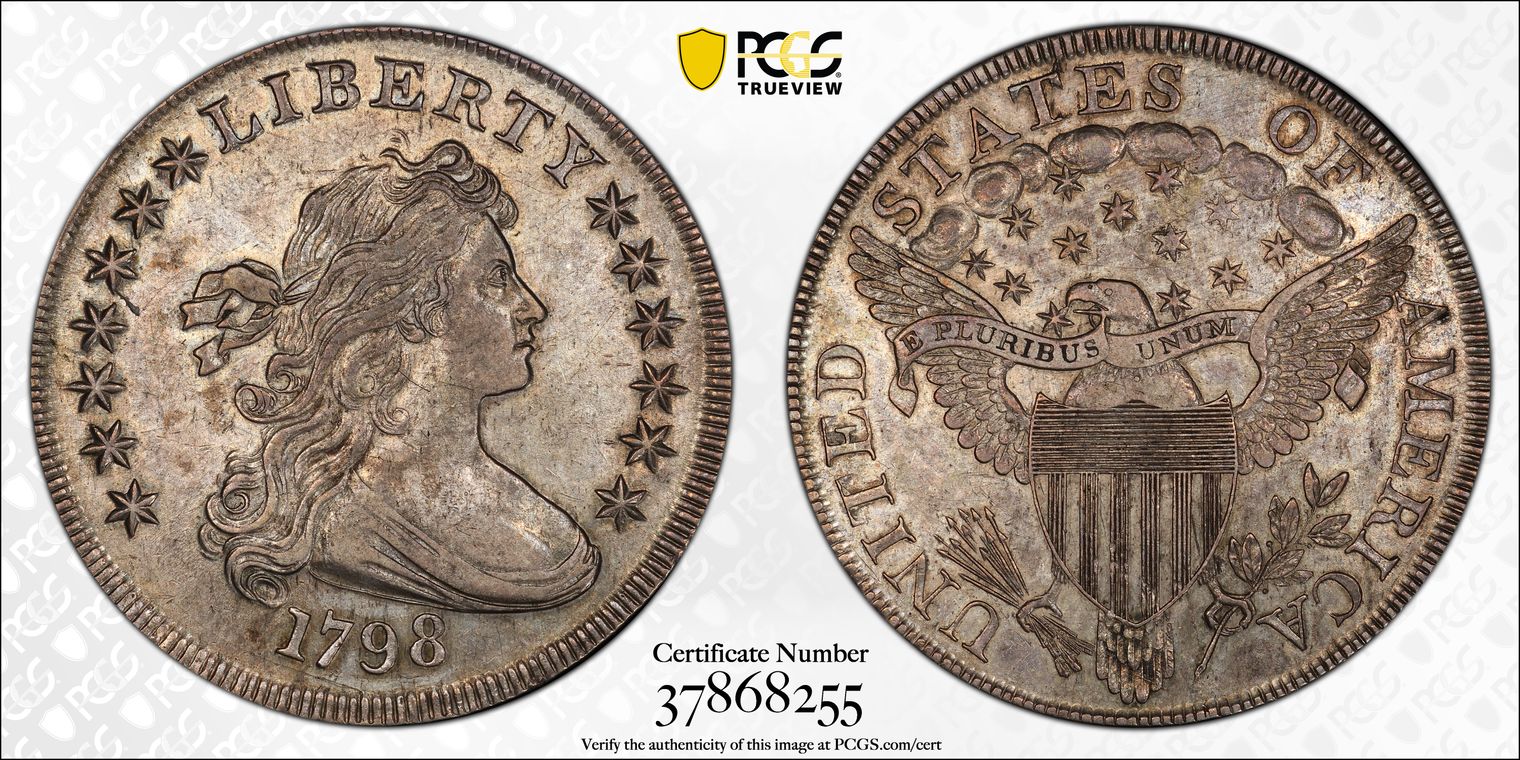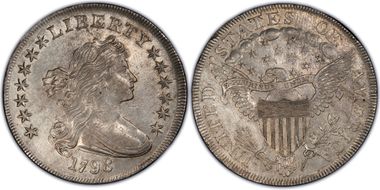1798 $1 BB-114 AU55 认证号37868255, PCGS号40031
拥有者评论
BB-114
专家评论
Q. David Bowers
The following narrative, with minor editing, is from my "Silver Dollars & Trade Dollars of the United States: A Complete Encyclopedia" (Wolfeboro, NH: Bowers and Merena Galleries, Inc., 1993). Note: the Notable Specimens list should be used with caution - it has been updated in my 2013 edition of "The Encyclopedia of United States Silver Dollars 1794-1804."B-26. H-26.
OBVERSE 13: See description under 1798 BB-113. On the BB-114 variety, a light die crack starts at border under 9 through two inner points of first star ending in field.
Obverse die used to strike BB-113 (1st use), 1798 BB-114 (2nd use), BB-115 (3rd use), BB-116 (4th use), BB-117 (5th use), BB-118 (6th use), BB-119 (7th and final use).
REVERSE L: Point of star touches point of upper part of eagle's beak; star points to left side of U. Line star pattern. 12 arrows and a stick. One of these arrows, the nearest one to N, has a very small head. (Haseltine called this' the 11-arrows variety.) There are five small berries, the two at top closest together. Claw close to A but not touching it. Point of leaf under center of! in AMERICA. Die track from shield to border below, passes through end of stem. Light die crack through top of ES, base of 0, right cloud, right wing and ribbon, outer leaves of branch, lower part of A and stem end, thence through eagle's tail. The two upper center stars touch clouds.
Reverse die used to strike 1798 BB-114 only.
DIE STATES:
Die State I: Obverse: Faint crack from denticles through center of 9 to bust. Additional crack up through inner points of star 1 and into field toward hair ribbons. An additional crack, very faint, from denticles, adjoining first two cracks, extends through denticles to right, curving up to bust. Reverse: Perfect die without cracks. May not exist with perfect reverse die.
Die State II. Obverse: As described for Die State I (the last-mentioned faint crack will be visible only on high-grade examples; cf. Bowers and Merena, Florida United Numismatists Convention Sale, 1993: 516). Reverse: Die crack from shield to border below, passes through end of stem. Light die crack through top of ES, base of 0, cloud 8, right wing and ribbon, outer leaves of branch, lower part of A and stem end, thence through eagle's tail.
Die State III. Obverse: As preceding. Reverse: Now with a heavy die crack on the reverse from the upper right top of the second T in STATES into the rim.
Die State IV. Obverse: As preceding. Reverse: Later state with additional .crack from top of cloud I, down through eagle's wing, to arrows, through tail, to stem end, joining earlier crack there. Additional crack through bottom of tail.
Die State V. Obverse: As preceding. Reverse: Still later state with crack from top of E in STATES, through top of S, bottom of 0, through cloud 8, wing, right side of branch, and final A in AMERICA, joining earlier cracks at stem end. Additional crack from rim above wing tip, through tops of AM of AMERICA, to border above E. Other cracks as Die State IV. The reverse die could not have functioned much beyond this point.
COLLECTING NOTES: 1798 BB-114 exists to the extent of 35 to 60 pieces, if indeed even that many, and is one of the classic rarities of the year. All or nearly all specimens are in grades from EF downward. I am not aware of any AU or Mint State coins.
NOTABLE SPECIMENS:
Kagin Specimen. EF-45. Kagin's, 1983 ANA Convention Sale, 1983:2667. "Pleasing warm even gray enhanced by splashes of peripheral gold tones. A few minor planchet defects visible (as made). Reverse trifle flat about eagle's head and with a couple of tiny rim nicks at left."
1993 FUN Convention Sale Specimen. EF-45. Bowers and Merena Galleries, Florida United Numismatists Convention Sale, 1993:516. "EF-45 to AU-50. Mottled iridescent and silver golden toning, possibly artificially applied, but if so, not particularly relevant-as the coin is very attractive overall."
DeCoppet Specimen; EF-40. James Kelly, Andre DeCoppet Collection, 1955. "Die break on reverse not distinct. EF, well struck."
River Oaks Specimen. EF-40. Bowers and Ruddy Galleries, River Oaks Collection (Glenn Davidson), 1976:698. "EF. Reverse center a bit weak as struck."
Seller Specimen. EF-40. Bowers and Ruddy Galleries, Seller Collection, 1980:3280. "Lovely gray and gold toning. A thread adhered to the reverse die when this was struck, leaving an impression on the coin."
Austin Specimen. VF-30. K. P. Austin via Liberty Coin Co., June 1954. A.J. Ostheimer, 3rd Collection. Superior Galleries, ANA Convention Sale, 1975:895. "Poorly struck up at centers, but relatively clean and attractive."
Willasch Specimen. VF-25. Superior Galleries, H. Roland Willasch Collection, 1990:505. "Cleaned to a bright white on the obverse and reverse, with a hint of toning starting to form on the reverse, the obverse suffering with cleaning lines on the surface. Late die state, similar-to the 1975 ANA Sale coin, Lot 895, with another reverse break from stem to tail, arrows, E in scroll, wing, and out the rim passing through TAT of STATES. A few other lesser cracks can be seen, which contribute to the poor striking on the stars above the eagle's head."
PCGS #
40031
设计师
Robert Scot
边缘
Lettered: HUNDRED CENTS ONE DOLLAR OR UNIT
直径
40.00 毫米
重量
27.00 克
铸币数量
287536
金属成分
90% Silver, 10% Copper
更高评级数量
2
评级较低的钱币数量
7
地区
The United States of America
价格指南
PCGS 数量报告
拍卖 - PCGS 评级的
拍卖 - NGC 评级的






















